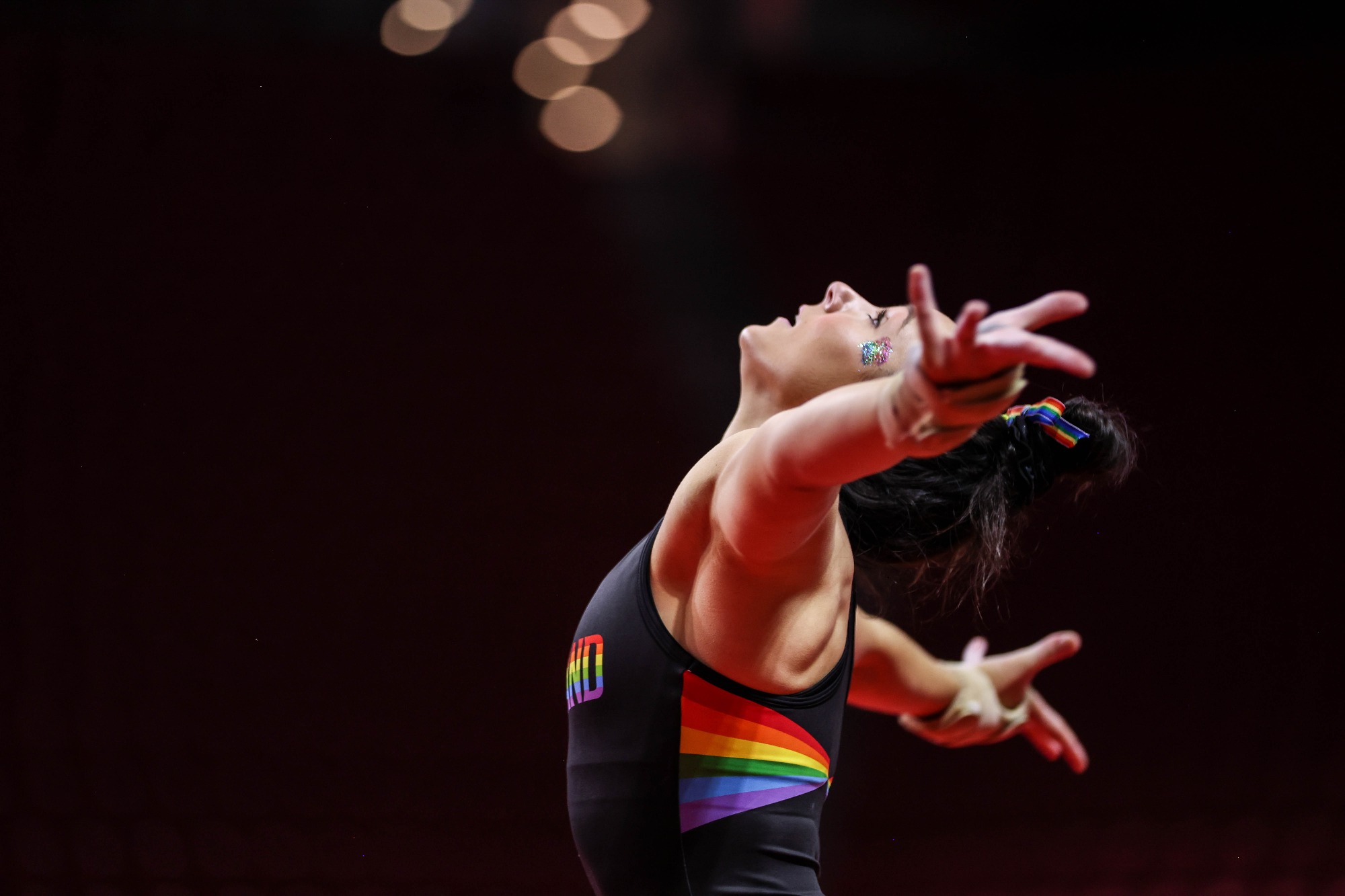When Kalyany Steele, a senior on UCLA’s famed gymnastics team, was growing up, she didn’t know any other queer gymnasts. “Queerness was never really normalized in women’s gymnastics,” she explains.
“It made [coming out] feel like a very big thing. It was much more nerve-racking that way.” In Spring 2020, during Steele’s first season at UCLA, only one athlete competing in women’s collegiate gymnastics, Michigan State University’s Ella Douglas, was publicly out.
But things were changing in women’s college gymnastics. In February 2020, the UCLA gymnastics team put on its first Pride meet. The team advertised the meet through a now-iconic video in which gymnasts performed leaps, splits and dips while holding the Pride flag and yelling “Gay rights!” Pauley Pavilion, UCLA’s indoor sports arena, was decked out in flags from the LGBTQ2S+ community.” Team members from both Arizona, the visiting team, and UCLA, wore rainbow ribbons in their hair, and whenever a UCLA gymnast stuck her routine, her teammates draped a Pride flag over her shoulders.
For Steele, the Pride meet was a turning point. She came out to her teammates as bisexual at the last practice before the meet. A few months later, she came out publicly in a video entitled “Love, Kalyany,” a message addressed to her younger self.
Steele was part of the first wave of openly queer collegiate women’s gymnasts—a wave that has only grown in size over the last three years. The podcast Half In, Half Out, which covers “LGBTQ+ culture in the gymnastics world” has been tracking the growing number of queer NCAA gymnasts since early 2020. “When we started [the podcast], we thought we were going to be talking about a lack of representation,” co-host Kino (who goes by her first name only) explains.
Instead, there are so many queer women in NCAA gymnastics that the podcast struggles to cover them all: at least 16 active college and university gymnasts publicly identify as queer, from Southeastern Conference (SEC) team champion Savannah Schoenherr (Florida), to EAGL rookie of the year Syd Morris (Long Island University), to All-American Sirena Linton (Arizona) and 2017 World All-Around Champion and Florida sophomore Morgan Hurd.
Pride meets, where a gymnastics team dedicates their competition to the LGBTQ2S+ community, play a crucial part in the rise of queer representation in college gymnastics. While college gymnastics is no stranger to theme meets, like breast cancer awareness meets or alumni meets, Pride meets are different because they’re seen as political. “No one is in opposition to breast cancer survivors, or alumni,” Blake (who also goes by first name only) co-host of Half In, Half Out explains. “Gymnasts are sticking their necks out when they don’t need to. You can’t soft-launch Pride.”
“These Pride meets and queer athletes represent a sea change for gymnastics, a sport where policing the gender binary is baked into the very structure of the sport.”
And gymnasts are sticking their necks out more and more: over the last 12 weeks of the 2023 season, at least 12 teams have hosted Pride meets, including top-10 powerhouses like Florida and UCLA. At Maryland’s March Pride meet, a record-breaking five teams wore Pride leotards, a significant financial investment in a sport where leotards cost upward of $500 a piece. Even in states actively hostile to LGBTQ2S+ rights, like Missouri and Arizona, which both recently banned trans athletes from competing in women’s sports, college teams are going out of their way to compete in front of Pride flags and trans rights flags.
These Pride meets and queer athletes represent a sea change for gymnastics, a sport where policing the gender binary is baked into the very structure of the sport. Gymnastics is so gender-segregated that men’s artistic gymnastics (MAG) and women’s artistic gymnastics (WAG) are functionally different sports. MAG and WAG athletes compete in different events: men compete on six (floor, vault, pommel horse, high bar, parallel bar, rings); women compete on four (vault, uneven bars, beam, floor). Trans and non-binary athletes are mostly out of luck: there is no real gender-neutral option in gymnastics, which means athletes who transition must either learn a new discipline, or train in a discipline that does not match their gender identity.
Even in the events the disciplines have in common (like floor), the performance style and skill set could not be further apart. WAG athletes perform to music, and their routines include dance elements like leaps, turns and jumps. MAG floor takes place entirely in silence, sans dance elements. The gap between the two disciplines is vigorously policed: when a male gymnast, Heath Thorpe, started adding dance elements to his floor routine, the Men’s Technical Committee refused to give the element credit.
The separation between men and women’s gymnastics dates back to the turn of the 20th century. Gymnastics was one of the first Olympic sports to include female competitors, in large part because the International Olympic Committee saw gymnastics as a suitably feminine sport. Aware of the precarity of their admission to the Olympics, gymnastics authorities shaped the sport to conform to gendered expectations for female athletes. They took out strength-based apparatuses like rings, added music to women’s floor routines and made dance integral to beam and floor. Gymnastics’ commitment to traditional—which is to say straight—femininity continues to this day. The sport’s Code of Points instructs judges to consider “feminine grace” in their scoring; and every time a more muscular gymnast wins major events, gymnastics insiders fret that the sport is straying too far from “elegance.”
Meanwhile, the elite Code of Points includes multiple rules about makeup (including that it must be “modest” and not “theatrical,” a rule put in place after Dutch gymnast Celine Van Gerner wore full cat facepaint during a Cats-themed floor routine). That strict adherence to femininity makes the sport hostile to queer WAG athletes: nearly every queer gymnast mentions the sport’s over-the-top femininity as a barrier to coming out.
“It’s been more taboo to be gay in the sport of gymnastics,” Schoenherr, a gay gymnast at the University of Florida, explains, “Gymnastics has that stereotype of being more feminine: gymnasts wear makeup, sparkly leos and bows in their hair. When people think of a gay woman, they think she’s masc.”
Ironically, it is precisely gymnastics’ obsession with over-the-top femininity that attracts queer fans. Unlike most sports, where fandom tends to trend male, a large segment of fans in gymnastics are young girls and queer adults. Blake posits that gymnastics is inherently appealing to queer audiences: “Competitive gymnastics and RuPaul’s Drag Race have all the same components: a competition that embraces queer aesthetics and values.”
In other words, gymnastics is a rare sport that values performance and femininity. Women’s routines are a spectacle of camp—you might watch a routine where the gymnast is sucked into a game of Pac-Man and must battle her way out (Claire Gagliardi, 2021), a routine set to “Barbie Girl” where the gymnast pretends to be a life-size plastic doll between tumbling passes (Rebekah Ripley, 2023) or a routine that serves as an homage to voguing and ballroom culture (Margzetta Frazier, 2023).
“As more and more queer gymnasts compete in women’s gymnastics, the sport’s queer subtext is becoming text.”
Aesthetics are a critical part of gymnastics: the leotard itself is an event for college teams, with each new leotard necessitating an unveiling on social media with a photo shoot, a video and loud fan reactions. Even the coaching staff get into the spirit of things: female coaches are often so dressed up that their heels are in danger of puncturing holes in the floor mats.
As more and more queer gymnasts compete in women’s gymnastics, the sport’s queer subtext is becoming text. For queer gymnasts, Pride meets provide both queer representation within gymnastics, and an opportunity to support the LGBTQ2S+ community outside the sport. “We know that thousands and thousands of people come to our meets, and even more watch on television,” says Schoenherr. “To see teams supporting their LGBTQ2S+ athletes—that means more to members of the LGBTQ2S+ community than anyone from the straight community could understand.”
Steele concurs. “A lot of people don’t get love and support for being queer. But if they can turn on the TV and see a whole competition dedicated to them, and dedicated to their identity—we’re helping that person.” Schoenherr and Steele have seen the impact of Pride meets first-hand: both continue to receive messages from young gymnasts who thank them for their stories, or say that Schoenherr and Steele inspired them to come out to families and teammates.
Yet, even as college gymnastics sees an increase in queer representation, major problems remain. Pride meets often go unmentioned in broadcasts: UCLA’s inaugural Pride meet was not mentioned once by the Pac-12 broadcasting team, even as gymnasts competed in rainbow attire. Elite gymnastics remains a hostile space: there is only one actively competing queer woman in elite gymnastics (South Africa’s Caitlin Rooskrantz).
Gender policing continues: Jackson Harrison, a non-binary college athlete competing in MAG, was told by their coach they could not wear makeup during competition. And while individual teams often want to celebrate their LGBTQ2S+ members, university administrations may balk at the potential backlash, especially in more hostile parts of the country.
Meanwhile, the spectre of legislation barring discussions of sexuality in higher education raises the question of whether it will be safe to put on Pride meets at all. Recent anti-drag and anti-trans legislation in the United States has Blake and Kino worried about the effect on trans and non-binary gymnasts in college gymnastics: “Some of these laws are written so broadly it legitimately may be illegal for [certain athletes] to compete in the version of the sport they currently compete in.”
Steele has never worried about backlash to Pride meets. “In the past, people have been worried about what other people could say. Personally, I’ve never worried, because the backlash proves why we need representation.”


 Why you can trust Xtra
Why you can trust Xtra


